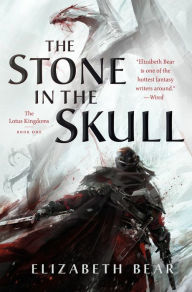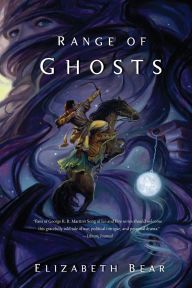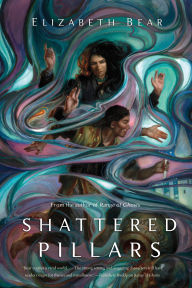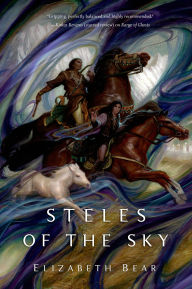The Stone in the Skull Is Elizabeth Bear at Her Best
The Stone in the Skull: The Lotus Kingdoms, Book One
The Stone in the Skull: The Lotus Kingdoms, Book One
Hardcover $27.99
From its opening pages, Elizabeth Bear’s The Stone in the Skull wears its virtues on its sleeve, introducing us to two characters, Dead Man and the Gage, who are immediately enigmatic, yet also compelling and achingly human ( doubly impressive for the Gage, a towering automaton powered by a human soul). They’re on a mission with dire yet mysterious stakes. And by the end of the first chapter, they’ve survived an attack by a deadly ice-wyrm and been rescued by a wizard with suspicious intentions.
Elizabeth Bear doesn’t beat around the bush.
Surrounding this pair are a caravan of misfit travellers—acrobats, a clever noblewoman, a petulant prince, and others, all with their own schemes and motivations. In a way, it feels like the opening roll call in Agatha Christie’s Murder on the Orient Express, though there’s no murder mystery at the heart of this epic fantasy. And this is where the book truly excels, beyond the magic-laced action scenes and top-tier worldbuilding—in the way Bear loads layered relationships between a whole host of characters into a relatively slim page count. With its flawed and broken cast, this book is filled to the brim with heart, an element sorely lacking from some epic fantasy novels that have become popular in our post-Game of Thrones world.
From its opening pages, Elizabeth Bear’s The Stone in the Skull wears its virtues on its sleeve, introducing us to two characters, Dead Man and the Gage, who are immediately enigmatic, yet also compelling and achingly human ( doubly impressive for the Gage, a towering automaton powered by a human soul). They’re on a mission with dire yet mysterious stakes. And by the end of the first chapter, they’ve survived an attack by a deadly ice-wyrm and been rescued by a wizard with suspicious intentions.
Elizabeth Bear doesn’t beat around the bush.
Surrounding this pair are a caravan of misfit travellers—acrobats, a clever noblewoman, a petulant prince, and others, all with their own schemes and motivations. In a way, it feels like the opening roll call in Agatha Christie’s Murder on the Orient Express, though there’s no murder mystery at the heart of this epic fantasy. And this is where the book truly excels, beyond the magic-laced action scenes and top-tier worldbuilding—in the way Bear loads layered relationships between a whole host of characters into a relatively slim page count. With its flawed and broken cast, this book is filled to the brim with heart, an element sorely lacking from some epic fantasy novels that have become popular in our post-Game of Thrones world.
Range of Ghosts
Range of Ghosts
In Stock Online
Paperback $18.99
The Dead Man and the Gage are our introduction to this world (or rather our reintroduction—though the book begins a new series, it is loosely tied to Bear’s magnificent, Mongolian-inspired Eternal Sky trilogy), but they are only one small piece of the puzzle. Mrithuri and Sayeh are beleaguered leaders, each clinging to their places as rajni of their people. Not coincidentally, both women are overcome with fear for the future—their own and that of their people—when they are met with ill omens portending coming doom. They are lonely islands within a crowded, cutthroat political system. As women, they fight to be seen as true leaders, and find solace and strength from unlikely sources as they desperately to what they crave most.
“We’ve been over this,” Mrithuri says, battering down yet another marriage proposal. “I’m not marrying someone who will want to rule me. This is my kingdom, and I will hold it in my own right.”
Though their life stories are very different, and Bear, with her usual craft and care, gives Mrithuri, Sayeh, the Dead Man, and the Gage different aspirations and perceptions of the world, the four principal protagonists share one common trait: loneliness. This is a crowded book, with many characters, further compressing the ache that eats at these four as they search for understanding and companionship. Particularly affecting is the relationship between the Dead Man and the Gage, who share much in common, despite their wildly divergent histories. While an automaton might seem like a poor conversationalist, Bear gives her mechanical man a heartfelt and nuanced personality, opening the door for interesting examinations of what it means to be human.
The Dead Man paused fifteen feet away. “Gage?”
“I saw you,” the Gage answered.
“You are the last person I should care to startle.” There was a smile in the words, under a friendly layer of acid. The Gage and the Dead Man understood one another.
“I’m not a person,” the Gage said.
The Dead Man flipped his hand in that dismissive gesture he liked so well. “Nor are you merely an automaton. And as you’ve no wings to speak of, you cannot be a dragon.”
“How would you know?”
“You look like no dragon.”
The Gage made an amused noise. “When have you ever seen a dragon?”
“Near enough to a dragon by my lights, not a month since in the mountain pass.”
“That?” The Gage dismissed it with an oiled metal shrug. “That was just a wyrm.”
The Dead Man and the Gage are our introduction to this world (or rather our reintroduction—though the book begins a new series, it is loosely tied to Bear’s magnificent, Mongolian-inspired Eternal Sky trilogy), but they are only one small piece of the puzzle. Mrithuri and Sayeh are beleaguered leaders, each clinging to their places as rajni of their people. Not coincidentally, both women are overcome with fear for the future—their own and that of their people—when they are met with ill omens portending coming doom. They are lonely islands within a crowded, cutthroat political system. As women, they fight to be seen as true leaders, and find solace and strength from unlikely sources as they desperately to what they crave most.
“We’ve been over this,” Mrithuri says, battering down yet another marriage proposal. “I’m not marrying someone who will want to rule me. This is my kingdom, and I will hold it in my own right.”
Though their life stories are very different, and Bear, with her usual craft and care, gives Mrithuri, Sayeh, the Dead Man, and the Gage different aspirations and perceptions of the world, the four principal protagonists share one common trait: loneliness. This is a crowded book, with many characters, further compressing the ache that eats at these four as they search for understanding and companionship. Particularly affecting is the relationship between the Dead Man and the Gage, who share much in common, despite their wildly divergent histories. While an automaton might seem like a poor conversationalist, Bear gives her mechanical man a heartfelt and nuanced personality, opening the door for interesting examinations of what it means to be human.
The Dead Man paused fifteen feet away. “Gage?”
“I saw you,” the Gage answered.
“You are the last person I should care to startle.” There was a smile in the words, under a friendly layer of acid. The Gage and the Dead Man understood one another.
“I’m not a person,” the Gage said.
The Dead Man flipped his hand in that dismissive gesture he liked so well. “Nor are you merely an automaton. And as you’ve no wings to speak of, you cannot be a dragon.”
“How would you know?”
“You look like no dragon.”
The Gage made an amused noise. “When have you ever seen a dragon?”
“Near enough to a dragon by my lights, not a month since in the mountain pass.”
“That?” The Gage dismissed it with an oiled metal shrug. “That was just a wyrm.”
Shattered Pillars
Shattered Pillars
In Stock Online
Paperback $18.99
As is common in Bear’s work, a vein of humor is laced through an otherwise serious story, even amid a philosophical pondering of what it means to be human The results are powerfully emotional. To see the Dead Man, grounded in religious beliefs that have recently been upturned, so effortlessly refer to the Gage as human, despite his automaton body—and despite the Gage’s protestations—is beautiful. One story element is placed atop the other—plot, characterization, worldbuilding—until the reader can no longer tell them apart.
“I leave my mark with ink on paper, with stylus in sand,” says the legendary poet Ümmühan, midway through the novel. “I am the mark I leave, and the mark I leave is me. I am the act of marking. You leave your mark in blood and sinew, and in the history that I shall help to record. That act is you, that act of marking. That act of leaving a mark.”
With every new story, Bear leaves her mark on the world. There is a weight to her worldbuilding, to the subtlety of her characterizations. Hers is a mark that identifies the boundlessness of epic fantasy, of worlds created by a singular mind, but shared and enjoyed by many.
As noted above, The Stone in the Skull is the sequel to Bear’s Eternal Sky trilogy, which concluded with 2014’s Steles of the Sky. That trilogy left its mark one me as one of the decades best epic fantasies, and changed my expectations of how fantasists should approach worldbuilding. “Range of Ghosts is wonderful and compelling,” I said of the first volume, “a truly great novel that moves the genre forward by challenging and embracing its history all at once.” This attention to detail continues here, as Bear shows us even more of her Asian-inspired fantasy world. Alongside other writers like Guy Gavriel Kay and Daniel Abraham, Bear shows how beautifully fantasy can blend historical influences and speculative imagination.
As is common in Bear’s work, a vein of humor is laced through an otherwise serious story, even amid a philosophical pondering of what it means to be human The results are powerfully emotional. To see the Dead Man, grounded in religious beliefs that have recently been upturned, so effortlessly refer to the Gage as human, despite his automaton body—and despite the Gage’s protestations—is beautiful. One story element is placed atop the other—plot, characterization, worldbuilding—until the reader can no longer tell them apart.
“I leave my mark with ink on paper, with stylus in sand,” says the legendary poet Ümmühan, midway through the novel. “I am the mark I leave, and the mark I leave is me. I am the act of marking. You leave your mark in blood and sinew, and in the history that I shall help to record. That act is you, that act of marking. That act of leaving a mark.”
With every new story, Bear leaves her mark on the world. There is a weight to her worldbuilding, to the subtlety of her characterizations. Hers is a mark that identifies the boundlessness of epic fantasy, of worlds created by a singular mind, but shared and enjoyed by many.
As noted above, The Stone in the Skull is the sequel to Bear’s Eternal Sky trilogy, which concluded with 2014’s Steles of the Sky. That trilogy left its mark one me as one of the decades best epic fantasies, and changed my expectations of how fantasists should approach worldbuilding. “Range of Ghosts is wonderful and compelling,” I said of the first volume, “a truly great novel that moves the genre forward by challenging and embracing its history all at once.” This attention to detail continues here, as Bear shows us even more of her Asian-inspired fantasy world. Alongside other writers like Guy Gavriel Kay and Daniel Abraham, Bear shows how beautifully fantasy can blend historical influences and speculative imagination.
Steles of the Sky
Steles of the Sky
In Stock Online
Paperback $20.99
For readers of that earlier series, many recognizable elements have rolled over—the lush world, the varied cast, the Asian-inspired setting, the way plot ties to the worldbuilding. However, where the original trilogy had a mythic feel, particularly in the second and third volumes, advancing the plot in broad strokes from a perspective that almost (but not quite) felt perched in the heavens, The Stone in the Skull is much more intimate, a journey more about the travails of the characters than an overarching world conflict.
The first book of the Lotus Kingdoms trilogy has all the elements necessary to not only to match its predecessor, but succeed it entirely. The Stone in the Skull begins a fantastic new saga, reminding us that Elizabeth Bear is truly one of the premier fantasists of her generation. If you’ve yet to discover her work, there’s no better time.
The Stone in the Skull is available now.
For readers of that earlier series, many recognizable elements have rolled over—the lush world, the varied cast, the Asian-inspired setting, the way plot ties to the worldbuilding. However, where the original trilogy had a mythic feel, particularly in the second and third volumes, advancing the plot in broad strokes from a perspective that almost (but not quite) felt perched in the heavens, The Stone in the Skull is much more intimate, a journey more about the travails of the characters than an overarching world conflict.
The first book of the Lotus Kingdoms trilogy has all the elements necessary to not only to match its predecessor, but succeed it entirely. The Stone in the Skull begins a fantastic new saga, reminding us that Elizabeth Bear is truly one of the premier fantasists of her generation. If you’ve yet to discover her work, there’s no better time.
The Stone in the Skull is available now.



